#Tremarctos ornatus
Text
Some San Diego Zoo babies from early April 2023.

7-week old Amur leopard.
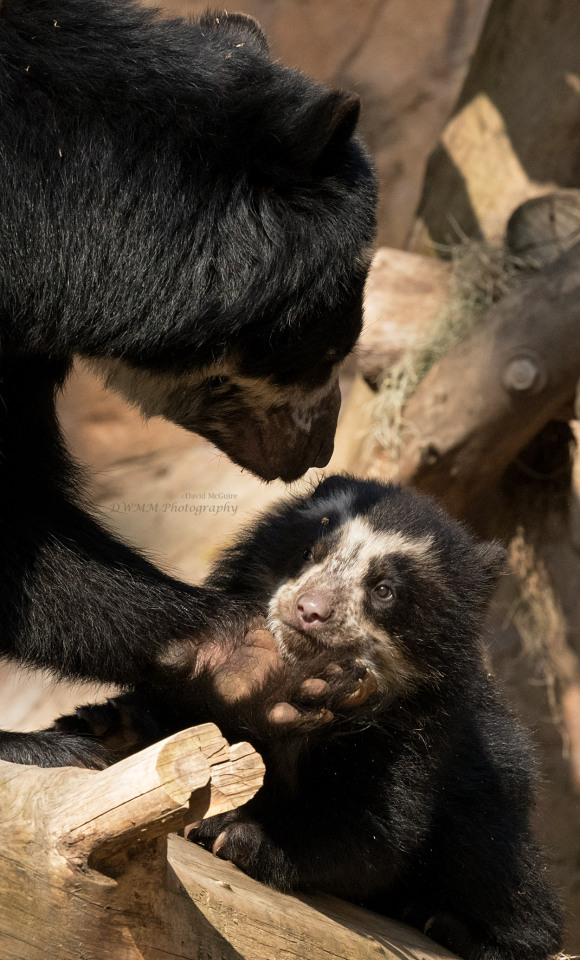
~4 month old Andean bear with mom
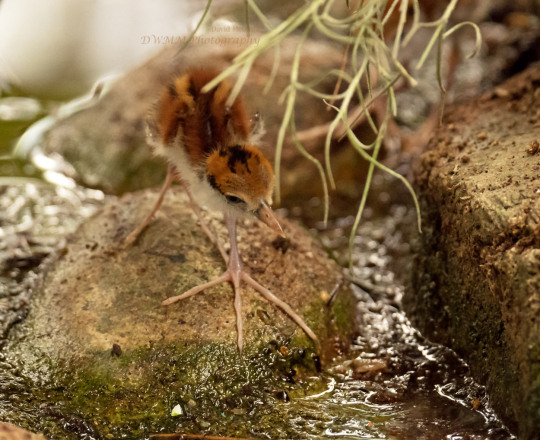
4 day old wattled jacana.
#Amur leopard#Andean bear#spectacled bear#San Diego Zoo#Panthera pardus orientalis#Tremarctos ornatus#Jacana jacana#wattled jacana#zoo babies#murder kitty#zoo photography
448 notes
·
View notes
Photo

Spectacled Bear for a $5 Ko-fi supporter
#art#my art#digital#digital art#clip studio#clip studio paint#csp#kofi#ko-fi#kofi commissions#commissioned work#request#doodle#coloured#bear#spectacled bear#andean bear#south american bear#mountain bear#Tremarctos ornatus#lazert#lazer-t
69 notes
·
View notes
Text
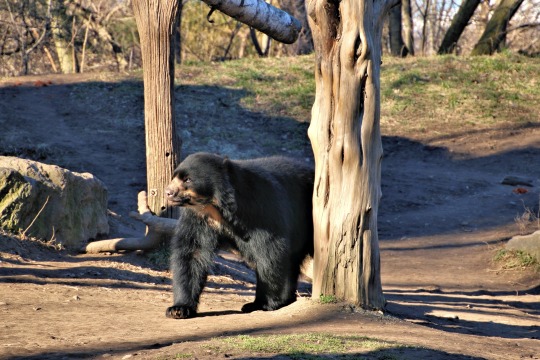

Andean Bear 🐻 Queens Zoo
#Andean Bear#Bears#South American Bear#Tremarctos Ornatus#Bear#Wildlife#Zoo#Wild Side#Sunlight#Cute Animals#Queens Zoo#Flushing Meadows#Corona Park#Queens#New York City#New York
7 notes
·
View notes
Photo

雨の証明写真
Rainy Passport Photo
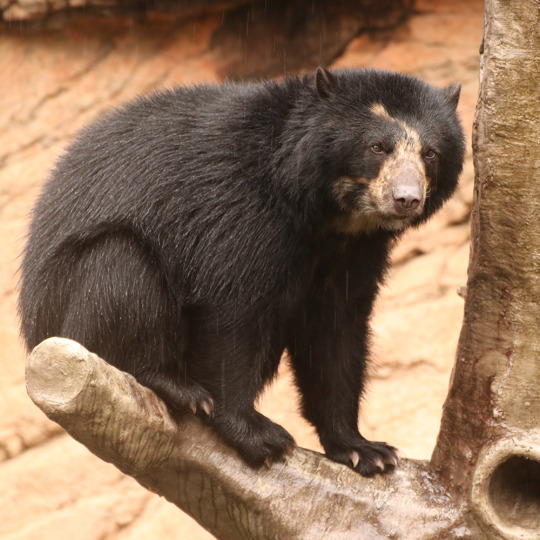
木登りに余念がありませんでした
@ズーラシア
She was completely engrossed in tree climbing.
@Zoorasia
27 notes
·
View notes
Text
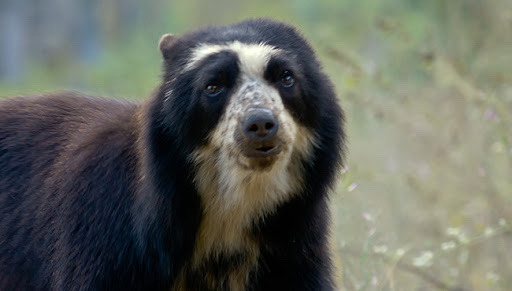
spectacular bear…
0 notes
Video
Playful Andean bear cub by ucumari photography
#ucumari photography#Andean#bear#Spectacled#Tremarctos#ornatus#cub#Salisbury#Maryland#Zoo#June#2022#DSC_6737#tongue#flickr
157 notes
·
View notes
Text
CoD The Other Good Guys Bear! Edition
What if the rest of the good guys in call of duty were bears? Part 2 - see Part 1 for 141 as bears
More bear facts! Cause bears are truly the best! 🐻💯
Alejandro: Mexican Grizzly Bear*
Ursus arctos nelsoni - now Ursus arctos horribilis

*depiction of what a mexican grizzly bear may have looked like alive
A now extinct subspecies of the grizzly bear that once inhabited northern Mexico. Due to its predation on cattle farms, they were considered pests and hunted by farmers. By the 1960s there were less than 30 individuals remaining. In 1974 the last known individual was shot in Sonora.
It was smaller than grizzly bears from the United states and Canada, and its colouration was said to range from a pale yellow to greyish-white with a darker undertone, though some individuals were described to be darker and reddish brown.
Due to its silvery fur, it was called 'el olso plateado' (the silvery bear) in Spanish, though it's name in the Ópatas language (an indigenous Mexican people's) was 'pissini'.
Rudy: Spectacled Bear "Andean Bear"
Tremarctos ornatus

The last remaining short-faced bear, native to the Andes Mountains in northern and western South America. Though all bears are omnivores, the spectacled bear has a mostly herbivorous diet with only 5-7% of their diet being meat.
The bear is named after it's distinctive eye markings, though not all spectacled bears may have such markings. Individuals can have highly variable fur patterns making it relatively easy to distinguish from one another.
It's short face and broad snout is thought to be an adaptation to a carnivorous diet despite it's herbivorous preferences.
Paddington Bear is said to be a Spectacled Bear from Peru.
Farah: Asian Black Bear "Moon Bear"
Ursus thibetanus
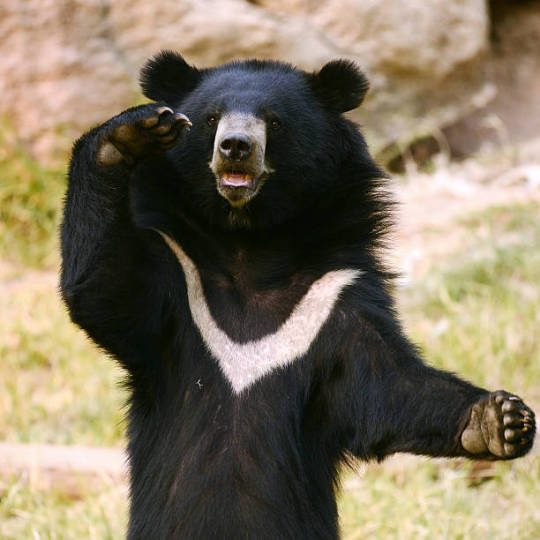
A medium sized bear native to Asia and highly adapted to arboreal life. It can be found in parts of Korea, China, Japan, eastern Russia, the Himalayas, southeastern Iran and northern India. It is listed as vulnerable due to deforestation and poaching for its body parts (used in traditional medicines).
The name 'moon bear' is given due to its distinctive creamy white cresent fur patch, though in some individuals it is "V" shaped. It has a powerful upper body stronger than it's lower limbs and are known to be the most bipedal of bears.
It has a reputation for extreme aggression despite their reclusive nature and there have been documented reports of unprovoked attacks. They are said to be more aggressive than the Eurasian Brown Bears that may cohabit the same areas and the American Black Bear.
Alex: American Black Bear
Ursus americanus

Alongside the Brown Bear, it is one of the only Bear species not threatened with extinction.
Despite living in North America, it is more closely related to the Asian Black Bear and Sun Bear than Grizzly Bears (North American Brown Bears) and Polar Bears. It's ancestors are thought to have split off from the Sun Bear.
Black Bears are distinguished from Grizzly Bears who may cohabit the same area, with their longer tall ears, straight face profile, shorter claws and lack of distinctive hump.
Teddy bears, Winnie-the-Pooh, and Smokey Bear are all inspired by the American Black Bear.
Nikolai: Polar Bear
Ursus maritimus
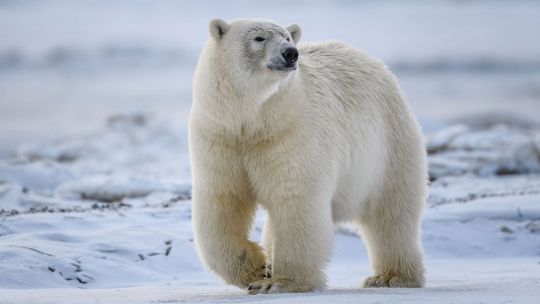
A large bear native to the Arctic. It is closely related to the Brown Bear and can hybridise with them though this is rare and not often seen. (See Grolar Bears)
They are the most carnivorous of all bear species (hypercarnivores), specialising in hunting seals through ambush attacks. Polar Bears are usually solitary but can be found in groups on land. They can form stable 'alliances' based on dominance hierarchies outside of breeding seasons with the largest males at the top.
It's common name was given in 1771, and was previously referred to as 'white bear', 'ice bear', 'sea bear', 'Greenland bear' in 13th - 18th century Europe. The Netsilik cultures (Inuit) named it 'nanook' and have several additional different names for them depending on sex and age of the polar bear.
Laswell: Kodiak Bear "Kodiak/Alaskan Brown Bear"
Ursus arctos middendorffi

Named after it's habitation of the Kodiak Archipelago in southwest Alaska, the Kodiak bear is the largest subspecies of Brown Bear, with some individuals comparable to the Polar Bear in size.
An island bear, it is 1.5-2x larger than it's mainland cousins the grizzly bear, though physically and physiologically, the two bears are very similar.
Due to its tendancy to feed in dense groups, it has thought to have developed more complex social behaviours (in comparison to mainland grizzly bears) to minimise infighting/fatalities via both verbal/ body posturing and social structures.
+
All info taken from wiki. Please let me know if ther any mistakes.
#cod mwii#cod mw2#call of duty modern warfare#cod mwiii#alejandro vargas#rudy parra#rudy cod#farah karim#farah cod#alex cod#nikolai cod#kate laswell#laswell cod#bears#bear facts
22 notes
·
View notes
Text
Types of Bears:
Black Bears:
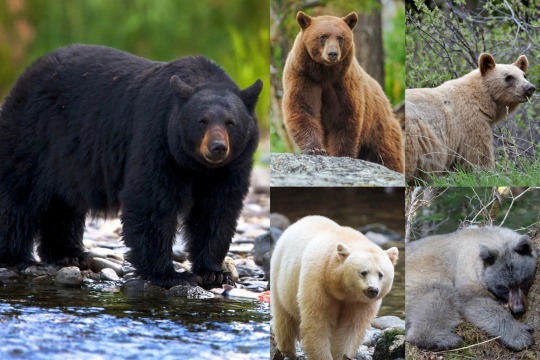
The American Black Bear (Ursus americanus) is a medium-sized bear species native to (you guessed it!) North America. Black Bears can be found in the forests as south as Florida and as North as Alaska. Being so widely distributed it’s no surprise that their population is twice the size of all the other bear species combined! Males generally weigh up to 500lbs, while females weigh up to 300lbs. The heaviest bear on record was found in North Carolina in 1998, weighing in at 880 lbs. Despite what their name may lead you to believe, they actually come in many different colors! They can be cinnamon, blonde, kermode or glacier bears as well as black! These bears are omnivores but their diet varies greatly depending on season, location, etc. They may eat berries, carrion nuts, insect larvae, fish, grasses, and small mammals. Although an adult Black Bear is quite capable of killing a person, they typically avoid any interaction or confrontations with humans. Attempts to relocate American black bears are typically unsuccessful, as the bears are able to return to their home range, even without familiar landscape cues.
Brown Bears:

The Brown Bear (Ursus arctos) is a species of large bear found across North America and Eurasia. In North America, the populations of brown bears are called grizzly bears, while the even larger subspecies that inhabits the Kodiak Islands of Alaska is known as the Kodiak bear. The largest populations are are in Russia with 120,000, the United States with 32,500, and Canada with around 25,000. Males generally weigh up to 600lbs , while females weigh up to 350lbs with the largest Brown Bear on record was a Kodiak that weighed 1,656 lbs. The Brown Bear is omnivorous and has been recorded consuming the greatest variety of foods of any bear. They may eat fish, carrion, insects, fungi, berries, flowers, nuts and small-medium sized mammals. Brown Bears do go out of their way to avoid humans but are much more likely to attack than Black Bears. They are formidable indeed, with females being extremely quick to aggression when with cubs.
Sloth Bear:

The Sloth Bear (Melursus ursinus), also known as the Indian bear, is a medium-sized bear species native to the Indian subcontinent. Their population inhabits the forests and grasslands of India, the Terai of Nepal, Bhutan and Sri Lanka. Males generally weigh up to 380lbs, while females weigh up to 210lbs with the biggest Sloth Bear on record weighing 423 lbs. Sloth Bears are considered myrmecophagous, meaning they feed on ants and termites. It has also been called the “labiated bear" because of its long lower lip and palate used for sucking up insects. They also may eat fruits and flowers. The Sloth Bear is one of the most aggressive bears alive which is likely due to the large human populations living so close to their habitats. These attacks are pretty frequent and if not fatal, the victim is often left terribly disfigured, as the bear strikes at the head and face.
Andean Bear:

The Andean Bear (Tremarctos ornatus) also known as the Spectacled Bear is a species of medium-sized bear native to the Andes Mountains in western South America. It is the only living species of bear native to South America, and the last remaining short-faced bear. Males generally weigh up to 340lbs, while females weigh up to 190 lbs with the largest Andean Bear on record weighing 440 lbs. Andean Bears are omnivores, eating small mammals, birds, and berries with their favorite foods being fruits and bromeliads. There have never been any reported attacks on humans.
Sun Bear:

The Sun Bear (Helarctos malayanus) is a species of small bear native to the tropical forests of Southeast Asia. They can grow up to be 150 lbs with males being 1/3 larger than the females. Sun bears get their name from the characteristic cream coloured chest patch! They are the most arboreal natured of all the bears with long claws fit for climbing trees. They feed omnivorously on insects, berries, fruits and mammals. They do not seem to hibernate, possibly because food resources are available the whole year throughout the range. Sun bears are shy and reclusive animals, and usually do not attack humans unless provoked to do so.
Polar Bear:

The Polar Bear (Ursus maritimus) is a species of large bear native to the Arctic Circle. Males generally weigh up to 1,200lbs, while females weighing up to 700lbs with the largest Polar Bear record weighing 2,209 lbs. Although most polar bears are born on land, they spend most of their time on the sea ice. Their scientific name means "maritime bear" and derives from this fact. Polar Bears are hypercarnivorous feeding primarily on ringed seals, but will also eat bearded seals, harp seals, hooded and harbor seals. Larger prey species such as walrus, narwhal and beluga are occasionally hunted. Due to location, attacks on humans are infrequent but potential chances of survival are very low. “If it’s black: fight back, if it’s brown: lay down, if it’s white: goodnight.”
(I'm experiencing a minor bear hyperfixation, if you can't tell!!! I hope this was beary educational for you ROFLROFLROFL)
#bear#bears#educational#grizzly bear#polar bear#black bear#spirit bear#sun bear#sloth bear#spectacled bear
107 notes
·
View notes
Text
The world has many bears.
BIG bear
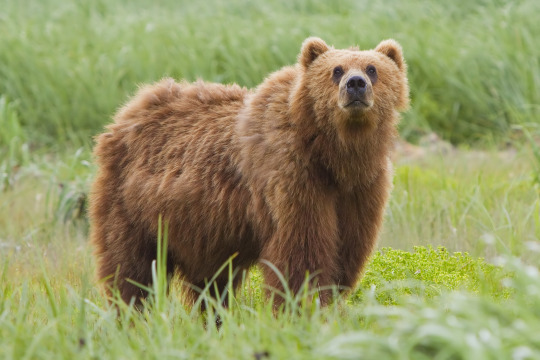
Smaller bear

Mickey Mouse cosplayer
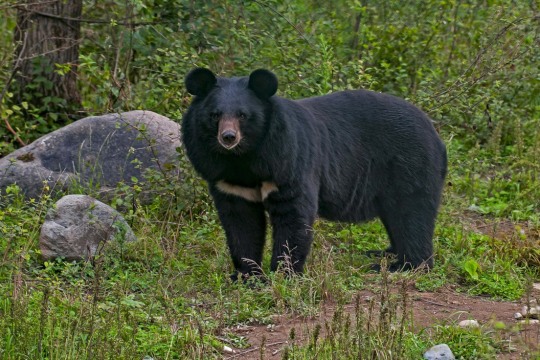
❌🛑 DANGER BEAR 🛑 ❌

stupid idiot bear

the guy from the Jungle Book
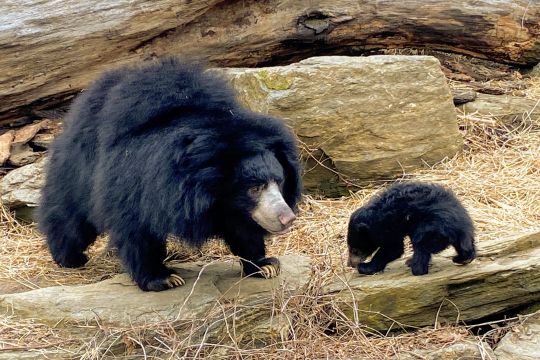
aliens

idk. fuck it. Spectacled bear (Tremarctos ornatus)
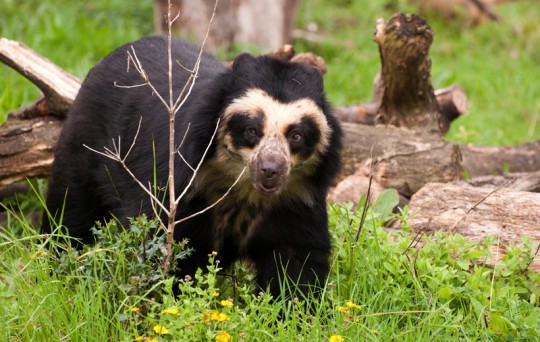
59 notes
·
View notes
Photo

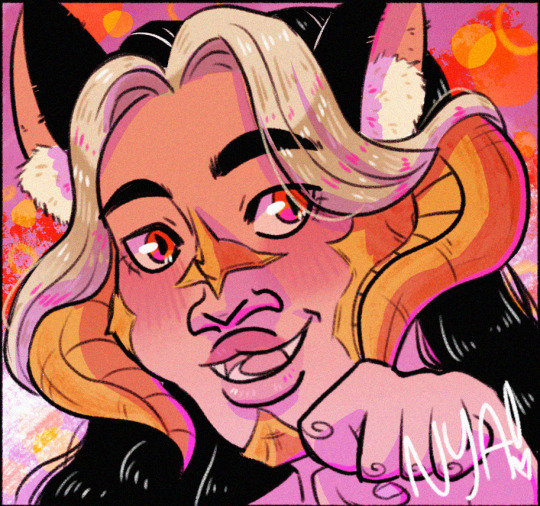

commissions for @tremarctos-ornatus of faer ocs and zenos!
#Final Fantasy XIV#zenos yae galvus#wol#warrior of light#FFXIV#ff14#chibi commission#icon commission
20 notes
·
View notes
Text
In the Intag Valley of Ecuador, at this “most biodiverse hotspot on the planet” (the cloud forests of the tropical Andes), local communities have engaged in 30 years of sustained defense of environment and resistance to multiple mining corporations, including Canada’s Copper Mesa Corporation. The group Defensa y Conservación Ecológica de Intag has helped plant tens of thousands of trees while establishing about 40 different forest reserves. Now the planet’s biggest copper producer company (Codelco) is targeting the Intag region, with wells already drilled and important court cases scheduled for 2023. Among the many unique orchids, moths, hummingbirds, plate-billed mountain toucan, spectacled bears, mountain tapirs, critically endangered brown-headed spider monkey, and other creatures, in Intag Valley there are two species of frog which live nowhere else on Earth, previously thought to be extinct: the longnose harlequin frog and the newly-named “rana cohete resistencia de intag” (”Intag resistance rocket frog”). The frogs now provide “hope” and are the subjects of Intag’s pending court cases.
From January 2023, Mongabay provides a thorough report about Intag’s cloud forest ecosystems, community projects, and resistance to mining. Excerpts from their report below.
---


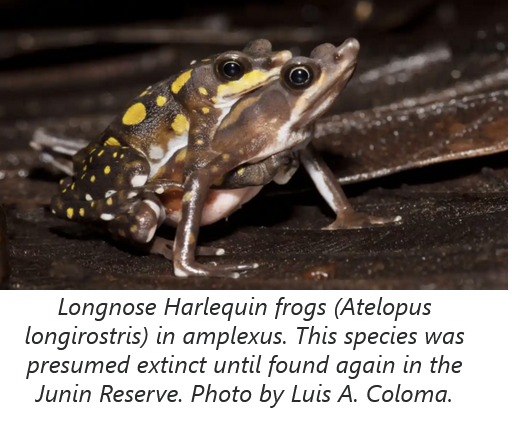






For nearly 30 years, communities have worked to conserve, restore and defend the cloud forests of the Intag Valley in Ecuador, in what locals say is the longest continuous resistance movement against mining in Latin America. The tropical Andes are considered the world’s most biodiverse hotspot, ranking first in plant, bird, mammal and amphibian diversity; however, less than 15% of Ecuador’s original cloud forests and only 4% of all forests in northwestern Ecuador remain. Codelco, the world’s largest copper producer from Chile, plans to open a mine in the Intag Valley that would destroy primary forest and lie within the buffer area of Cotacachi Cayapas National Park — a plan that experts say would be ecologically devastating and not worth the cost. Communities are using the presence of two threatened frog species — previously thought to be extinct — at the mining site to challenge the project [...].
In the 1960s, to encourage development, the government deemed forested properties with no human occupants “unproductive” and open to land grabbers. In turn, landowners were forced to clear at least 50% of the land to prove it was in use. These agrarian laws led to a flurry of deforestation that lasted into the 1990s. [...]
Pumas (Puma concolor), spectacled bears (Tremarctos ornatus), mountain tapirs (Tapirus pinchaque), mantled howler monkeys (Alouatta palliata), the critically endangered brown-headed spider monkey (Ateles fusciceps fusciceps), and the colorful plate-billed mountain toucan (Andigena laminirostris) are just a few of the more charismatic threatened species living here. [...]
Our first foray deep into this “terrestrial coral reef” is led by Roberto Castro, a local nature guide, environmental educator, and Zorrilla’s friend and neighbor. [...]
“Here is the Sangre de Drago tree … its red sap [is] a cure for many ailments,” he says. “Here is the Cecropia tree that lives in partnership with the ants.”
He shows us a white flower that shares its nectar with just one bat species and lets go of its seeds in a grand explosion once the nectar is spent. We see the sickle-winged guan (Chamaepetes goudotii), a large ground bird that lays only one, maybe two, precious eggs in a year. The famed Andean cock-of-the-rock (Rupicola peruvianus) cries out, its song somewhere between that of a parrot and a squealing pig. In the cloud forest, a single leaf is a stage for drama: ants farming aphids, lichens making their slow march against the moss. The forest drips with life.
We stop in a grove of massive elephant ear plants, twice as tall as a person. “These plants tell us water is abundant,” Castro says. The water trail leads us to a 10-meter (33-foot) waterfall. Castro stands in the stream below and pulls out a minuscule underwater castle made from pebbles.
“This is the home of moth larvae,” he shows us. [...]
Zorrilla and other community members started the environmental group Defensa y Conservación Ecológica de Intag (DECOIN) in 1995. [...] DECOIN helped communities establish 38 small-scale forest reserves that, altogether, protect almost 12,000 hectares (nearly 30,000 acres) of forest within the buffer zone of Cotacachi Cayapas National Park. [...]
In Intag, communities are self-defined administrative units, whose leader is nominated by its residents. It’s up to each community to decide how to best protect forests. Most include agreements prohibiting activities such as [...] cattle ranching, mining [...]. Bolaños and fellow community members planted more than 60,000 trees on slopes that were originally forests but had been converted to pasture decades ago. Working for six months each year between 2008 and 2013, dozens of community members planted 22 native species [...].
Intag’s richness aboveground is rivaled by a different kind of wealth below: copper. [...]
In 1996, the Japanese mining company Bishimetals, a subsidiary of Mitsubishi Corporation, found evidence of massive copper deposits in the Intag Valley. [...] In 1997, local communities reacted [...]. No one was harmed in the incident, but it was enough to make the company pull out. [...] After Bishimetals retreated in 1997, things calmed down until the Canadian mining company Copper Mesa Corporation (formally Ascendent Copper) entered the scene in 2004. [...] The company tried for five years to develop the project and used paramilitaries and violent force, Zorrilla tells Mongabay. [...] DECOIN helped residents file a lawsuit against both the mining company and the Toronto Stock Exchange for complicity in human rights violations based on Copper Mesa’s actions. [...] [I]n 2010 the Toronto Stock Exchange delisted Copper Mesa Mining Corporation.
---
Now, the communities face the world’s largest copper producer, Chile’s Codelco, which has partnered with Empresa Nacional Minera (ENAMI EP), Ecuador’s state-owned mining company, and invested millions into advanced mining explorations across Intag — in particular within the 5,000-hectare (12,400-acre) mining concession known as Llurimagua. [...]
According to several community members Mongabay spoke to, around 400 military and police officers used force to ensure the presence of Codelco and ENAMI in the mining concession. [...] Javier Ramirez was the president of the Junín community in 2014 when he was arrested for “sabotage and rebellion against the state.” [...] Codelco persisted and set up camp in the Junín Community Reserve, a patch of primary, old-growth forest [...].
Codelco has installed at least 90 drilling platforms within the reserve, digging down to depths of 1,200 meters (3,900 feet). [...]
The U.S. nonprofit Earth Economics [...] valued ecosystem services in Intag, such as water, food, climate regulation, soil retention, pollination, waste treatment, recreation, and scientific research, at $447 million per year in 2011. That’s higher than the projected revenue from copper mining in the region [...].
At the base of a waterfall, we stop to catch our breath, and Zorrilla steps forward. “This is close to where they found the frogs,” he says.
And here enters hope.
Among the dozens of threatened species in the tropical Andes, two have been found in this reserve and nowhere else on Earth: the longnose harlequin toad (Atelopus longirostris) and the Intag resistance rocket frog whose name was chosen through a contest. Both were presumed extinct until they were recently found again in the Junín Community Reserve. [...]
Finding these frogs has given the community a strong argument to try to legally stop mining development [...].
In September 2020, the Intag communities won one of the few cases upholding the rights of nature in the lower court. But the case was overturned in the higher provincial appeals court due to a procedural error. [...] The case is now before a three-member appeals court. After months of delay, a new judge was appointed in December. The new judge wants to have all of the evidence presented again, essentially starting the process over. The next court hearing is scheduled for Jan. 23 [2023]. [...]
We speak with Norma Bolаños about Mujer y Medio Ambiente (Women and the Environment), a group of nearly 50 women in Intag who make products out of cabuya, a fiber they produce from the agave plant, and color with natural dyes. [...]
In Cotacachi, we visit the home of Cenaida Guachagmira. She’s 28, the same age as the resistance movement, and has known this fight her whole life. [...] “The companies have their weapons and we have our dignity,” Guachagmira told Re:wild in an interview earlier this year.
---
Headline, images, captions, and all text published by: Liz Kimbrough. “In Ecuador, communities protecting a ‘terrestrial coral reef’ face a mining giant.” Mongabay. 9 January 2023. [Italicized heading and first paragraph in this post added by me.]
33 notes
·
View notes
Text


Andean Bears 🐻 Queens Zoo
#Andean Bear#Bears#South American Bear#Tremarctos Ornatus#Bear#Wildlife#Zoo#Wild Side#Sunlight#Shrub#Tree#Cute Animals#Queens Zoo#Flushing Meadows#Corona Park#Queens#New York City#New York
7 notes
·
View notes
Text
Name 10 favorite songs with names in the title:
tagged by@annieofhearts <3
Clementine - Halsey
Barbie and Ken - Scene Queen
Persephone - Sidney Gish
Just Monika: A Doki Doki Literature Club Song - Random Encounters OR30, Adrian Figueroa
Talia - King Princess
You & Jennifer -bülow
Medusa - Kailee Morgue
Baxter 3rd is Under Fucking Siege - Penelope Scott
Samson - Regina Spektor
Kyle and the Kids - The Bojack Horseman Soundtrack
tagging @ivanhoe-dont-do-it, @runawaymarbles, @tremarctos-ornatus, @galwithalibrarycard, @sirenofthetimes and @kierpenta
#i promise the last one is not a joke#idk man idk#also i did in fact have to go through my spotify for this bc this was suprisingly hard
5 notes
·
View notes
Text

Artist: Guri Arte “UKUKU UKURI” (Quechua)
This work represents the spectacled bear (Tremarctos ornatus) also known as “Jukumari” in the Aymara language.
It is the only species of bear that inhabits the South American continent and is in danger of extinction, due to the reduction of its habitat and indiscriminate hunting.
The origin of Ukuku is found in the Andean worldview: it is a mythological being born from the union of a woman with a spectacled bear, from which he inherits his wisdom and strength.
This half-human, half-bear Andean warrior is represented in dances and rituals, his objective is to safeguard the conduct of his people, however, his main function is to climb the highest snow-capped mountains of the mountain range to chop a piece of ice that He will come down for the ceremony of purification of the community and its first harvests.
11 notes
·
View notes
Text
Large terrestrial mammals are more vulnerable to the acoustic impact of drones than to the visual impact, study finds
https://sciencespies.com/nature/large-terrestrial-mammals-are-more-vulnerable-to-the-acoustic-impact-of-drones-than-to-the-visual-impact-study-finds/
Large terrestrial mammals are more vulnerable to the acoustic impact of drones than to the visual impact, study finds
Large terrestrial mammals are vulnerable to the acoustic sounds of drones, technological systems which are increasingly used to study the wildlife in open habitats such as the savanna and marshes. This is one of the conclusions revealed in a new study published in the journal Drones, which has been led by the experts José Domingo Rodríguez-Teijeiro, from the Faculty of Biology and the Biodiversity Research Institute of the University of Barcelona (IRBio); Margarita Mulero-Pázmány, from the University of Malaga, and Serge A. Wich, from the Liverpool John Moores University (United Kingdom).
Several studies state that drones that are used for scientific and recreational purposes can become a new source of disturbance for many animal species. However, there are still few studies identifying the actual factors associated with these devices that can negatively affect the animals’ behaviour.
Drones and wildlife: opportunity or thread?
The use of unmanned aerial systems (UAVs or drones) is becoming increasingly widespread in wildlife monitoring and conservation studies. Obtaining scientific data with a high spatial and temporal resolution, low operational costs, and simple logistics — without compromising the physical safety of researchers — would explain the widespread scientific use of this technology, especially in the study of large mammals in open or inaccessible areas.
The first author of the new study is Geison Pires Mesquita, from the Baguaçu Institute for Biodiversity Research (IBPBio, Brazil), an organisation committed to research, environmental education and biodiversity conservation. The study analyses the reaction of 18 species of large mammals to noise emitted by a drone in the large ex situ areas of the São Paulo Zoo (Brazil).
The 18 species studied belong to 14 families, namely: addax (Addax nasomaculatus); cattle (Bos taurus); waterbuck (Kobus ellipsiprymnus); dromedary (Camelus dromedarius); maned wolf (Chrysocyon brachyurus); red deer (Cervus elaphus); sambar (Rusa unicolor); Asian elephant (Elephas maximus); imperial zebra (Equus grevyi); jaguar (Panthera onca); Bengal tiger (Panthera tigris tigris); giraffe (Giraffa camelopardalis); hippopotamus (Hippopotamus amphibius); giant anteater (Myrmecophaga tridactyla); white rhinoceros (Ceratotherium simum simum); warthog (Phacochoerus africanus); tapir (Tapirus terrestris) and the spectacled bear (Tremarctos ornatus).
advertisement
Birds and mammals, the most studied using drones
Birds and mammals are the two groups of animals most studied with drones and the most affected by the recreational use of these devices. “Especially, large mammals are the most studied with drones because of their size, as they are easier to identify using aerial images,” says Geison Pires Mesquida, postdoctoral researcher, who included this study in his doctoral thesis defended in February 2022. “In addition to size — he adds — the type of habitat of the species is another determining factor for using drones in wildlife studies.”
The drone survey of wildlife was adapted to the Brazilian National Civil Aviation Agency (ANAC) regulations, which limit drone flights to a maximum of 120 metres. In addition, all flights were VLOS (Visual Line-Of-Sight) flights, i.e. they were required to be within the pilot’s line of sight. All flights were conducted at times when there were no visits to the zoo in order to avoid any disturbance due to external factors. Audiograms were also available in the scientific literature for 12 of the 18 species analysed — of the same or similar species — allowing for a more specific analysis of the influence of the frequency and intensity of drone-generated sleep.
The flights started at a maximum altitude of 120 metres. Once the drone was over the individuals, it began to descend until the animal showed an atypical behaviour. “A limit of 10 metres above the animals was established if the animal showed no behavioural changes, but in no case did the drone descend to that height because the animals showed behavioural changes at a higher altitude,” says Pires Mezquita.
The Asian elephant, sensitive to low-frequency sounds
In general, species with higher biomass — elephants, rhinos, giraffes, zebras and the waterbucks — showed a change in behaviour with drones at higher altitudes (and therefore lower decibels). As this group of animals is the most studied on land using drones — especially in open habitats such as the African savannah — terrestrial mammalian megafauna would be more likely to suffer from the effects of drone noises.
advertisement
The results reveal that the low-frequency sound pressure level particularly affected the behaviour of the Asian elephant, but not that of the other species studied, which were more sensitive to noise at medium and high frequencies.
“These results explain why the elephant is one of the few mammal species capable of hearing low-frequency sounds (below 0.25 kHz), or infrasound (frequencies below 0.0125 kHz). Both the size of the tympanic membrane and the size of the ossicular chain and the spaces in the middle ear are compatible with sensitivity to low frequencies,” says José Domingo Rodríguez-Teijeiro, professor emeritus in the UB’s Department of Evolutionary Biology, Ecology and Environmental Sciences.
“Low-frequency sounds — the expert continues — propagate more easily due to the physical characteristics of their sound waves than high-frequency sounds. It is believed that elephants can communicate more than 10 kilometres away by emitting and receiving these infrasounds.”
Each type of animal exhibits a specific behaviour of caution, irritation or escape. In addition, animals in ex situ environments — such as zoos — may exhibit even more specific behaviours. For this reason, the study involved the participation of Luan Henrique Morais, the zoo’s head of mammal management. This expert has known each of the animals for years and informed the team if he noticed that any animal was affected by the noise of the drone.
In the case of the Asian elephant, head-shaking movements were observed in the presence of the drone. In the felines, grunting and sudden body movements; in the spectacled bear, sudden leg and head movements. In the case of deer and warthogs, attempts to escape from their location are examples of behaviours that showed adverse reactions in response to the drone noise.
It is noteworthy that “most of the species we studied did not show any behavioural reactions to the presence of the drone at an altitude of 100 metres or higher, which is the altitude at which it usually flies over the ground to carry out wildlife censuses. This confirms that the responsible use of these systems is a low-impact tool for the study of mammals,” says lecturer Margarita Mulero-Pázmány (UMA).
Visual versus acoustic impact
Although this experiment does not allow us to fully discriminate between the effects generated by the impact of the acoustic or visual stimulus of the drone on the fauna, it was possible to indirectly deduce that the first effect caused by the drone on the species is acoustic. This conclusion was reached through the analysis of visual acuity — measured in cycles per degree (c/g) — which determines the ability to detect, discriminate and recognise objects against a background.
“All the species studied have a visual acuity of less than 50% of that of the human species (60 c/g). We can therefore deduce that the first impact caused by the drone on the species was acoustic, if we take into account the reduced visual capacity of the mammals analysed, the difficult detection of the drone used by the human eye at 50 metres, and the fact that the heights at which changes in behaviour occurred were on average higher than 50 metres,” says the researcher.
“According to the available information — the researcher continues — , this is the first time this factor has been analysed. Understanding that drone noise has an impact on some mammal species earlier than visual noise can help to improve current drone studies on these species and minimise the negative effects of recreational use in areas where these species are present.”
In wildlife studies, the sound profile of the drone model should also be considered, it is a factor that has so far not been considered if its negative impact is to be minimised. “Although there are many drone models on the market, there are still few commercial models being used to study wildlife. Trying to understand how much noise these models generate is a necessary step to make the use of drones in wildlife studies more effective,” concludes José Domingo Rodríguez-Teijeiro.
#Nature
4 notes
·
View notes
Text
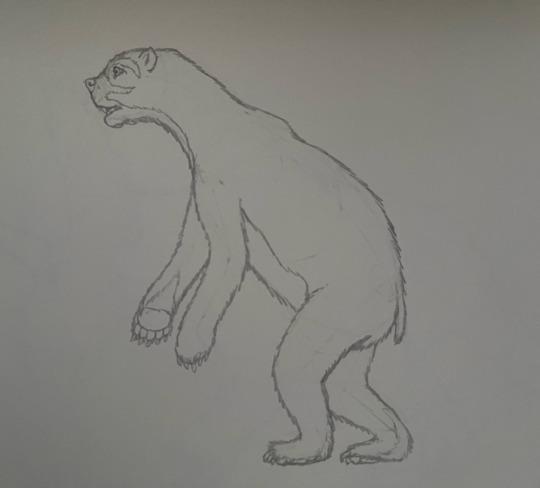
Arctotherium angustidens was a short-faced tremarctine bear from the Pleistocene of South America. Upper limits for this species of giant bear may have topped out at a height of 14 ft. and a weight approaching 2 tons, making it the largest known bear and a contender for largest land mammal carnivore ever. Its lineage has since suffered a substantial decrease in diversity, today only being survived by the spectacled bear (Tremarctos ornatus).
5 notes
·
View notes